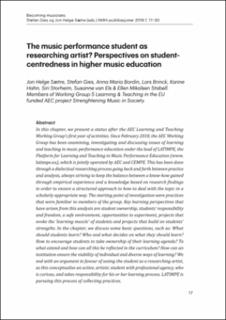| dc.contributor.author | Sætre, Jon Helge | |
| dc.contributor.author | Gies, Stefan | |
| dc.contributor.author | Bordin, Anna Maria | |
| dc.contributor.author | Brinck, Lars | |
| dc.contributor.author | Hahn, Karine | |
| dc.contributor.author | Storheim, Siri | |
| dc.contributor.author | Els, Susanne van | |
| dc.contributor.author | Stabell, Ellen Mikalsen | |
| dc.date.accessioned | 2021-11-01T14:53:35Z | |
| dc.date.available | 2021-11-01T14:53:35Z | |
| dc.date.issued | 2019 | |
| dc.identifier.citation | I: Becoming musicians. Student involvement and teacher collaboration in higher music education, s. 17-30 | en_US |
| dc.identifier.isbn | 978-82-7853-272-0 (pdf) | |
| dc.identifier.issn | 2535-373X (elektronisk utgave) | |
| dc.identifier.uri | https://hdl.handle.net/11250/2827023 | |
| dc.description | Paper from the conference "Becoming Musicians. Student involvement and teacher collaboration in higher music education" - Oslo, October 2018. -
Members of Working Group 5 Learning & Teaching in the EU funded AEC project Strenghtening Music in Society. | en_US |
| dc.description.abstract | Abstract -
In this chapter, we present a status after the AEC Learning and Teaching Working Group’s first year of activities. Since February 2018, the AEC Working Group has been examining, investigating and discussing issues of learning and teaching in music performance education under the lead of LATIMPE, the Platform for Learning and Teaching in Music Performance Education (www. latimpe.eu), which is jointly operated by AEC and CEMPE. This has been done through a dialectical researching process going back and forth between practice and analysis, always striving to keep the balance between a know-how gained through empirical experience and a knowledge based on research findings in order to ensure a structured approach to how to deal with the topic in a scholarly appropriate way. The starting point of investigation were practices that were familiar to members of the group. Key learning perspectives that have arisen from this analysis are student ownership, students’ responsibility and freedom, a safe environment, opportunities to experiment, projects that evoke the ‘learning muscle’ of students and projects that build on students’ strengths. In the chapter, we discuss some basic questions, such as: What should students learn? Who and what decides on what they should learn? How to encourage students to take ownership of their learning agenda? To what extend and how can all this be reflected in the curriculum? How can an institution ensure the viability of individual and diverse ways of learning? We end with an argument in favour of seeing the student as a researching artist, as this conceptualise an active, artistic student with professional agency, who is curious, and takes responsibility for his or her learning process. LATIMPE is pursuing this process of collecting practices. | en_US |
| dc.language.iso | eng | en_US |
| dc.publisher | Norges musikkhøgskole | en_US |
| dc.relation.ispartofseries | NMH-publikasjoner;2019:7 | |
| dc.title | The music performance student as researching artist? Perspectives on studentcentredness in higher music education | en_US |
| dc.type | Chapter | en_US |
| dc.type | Peer reviewed | en_US |
| dc.subject.nsi | VDP::Humaniora: 000::Musikkvitenskap: 110::Musikkpedagogikk: 114 | en_US |
| dc.source.pagenumber | S. 17-30 | en_US |
